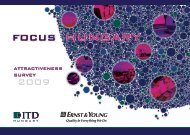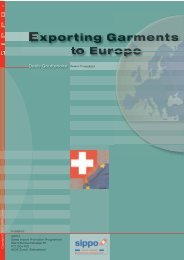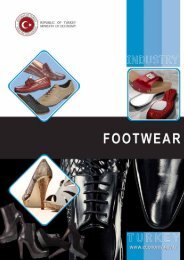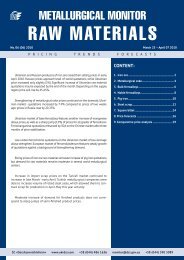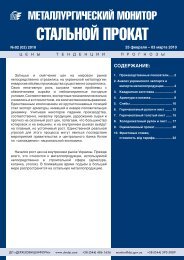Export Marketing Survey: German Market for Textile and Clothing
Export Marketing Survey: German Market for Textile and Clothing
Export Marketing Survey: German Market for Textile and Clothing
You also want an ePaper? Increase the reach of your titles
YUMPU automatically turns print PDFs into web optimized ePapers that Google loves.
This Project is financed<br />
by the European Union<br />
Support to <strong>Export</strong> Promotion<br />
<strong>and</strong> Investment Attraction in<br />
the Republic of Moldova<br />
EuropeAid/126810/C/SER/MD<br />
This Project is implemented by a<br />
Consortium led by GFA<br />
Consulting Group<br />
Consumption trends<br />
Price-quality<br />
ration<br />
Individualisation<br />
of consumption<br />
Fast fashion<br />
Growing low-price<br />
segment<br />
Dynamic men’s<br />
wear market<br />
Increasing<br />
dem<strong>and</strong> <strong>for</strong> plus<br />
size<br />
The market <strong>for</strong> clothing is becoming more mature <strong>and</strong> saturated, with<br />
abundance of producers <strong>and</strong> retailers offering fashionable clothes.<br />
<strong>German</strong> consumers are price sensitive <strong>and</strong> are mindful of a good price‐quality<br />
ratio. The consumer behaviour also tends towards “cross‐shopping”, meaning<br />
that the customer makes use of various sales channels (e.g. online‐shopping,<br />
discounter, single br<strong>and</strong> store).<br />
Furthermore there is a clear tendency towards individualisation of consumption,<br />
leading to differentiated customer request. Especially the sale of clothing<br />
accessories benefit from this trend, as many consumers rely on fashion<br />
accessories to embellish an outfit to distinguish them from others.<br />
The market saturation <strong>and</strong> trend individualisation of consumption is leading to<br />
“fast fashion” ‐ a rapid change of fashion collections . For instance, the average<br />
number of collections on sale in 2007 was 4,7 whereas in 2010 manufactures <strong>and</strong><br />
retailers will present up to 6,8 collections (of which 80% are upmarket articles).<br />
The outwear market in wide spread, reaching from high price luxury <strong>and</strong> upper<br />
middle price segment (together approx. 20% market share) to low middle <strong>and</strong><br />
very low price segment (approx. 50% market share). The overall development of<br />
the market reflects the growing disparity between the different economic strata<br />
of <strong>German</strong> society, <strong>and</strong> the increasing number of poor <strong>and</strong> relatively poor <strong>German</strong><br />
residents. Thus many <strong>German</strong> consumers with lower incomes will continue to<br />
seek low‐price clothes in a steadily growing discount sector. On the other h<strong>and</strong>,<br />
quality <strong>and</strong> convenience will become more important, <strong>and</strong> the youthful outlook of<br />
the older consumers will strengthen designer <strong>and</strong> sports labels.<br />
The men’s wear market is expected to become the most dynamic, driven by the<br />
increasing number of men who are fashion‐conscious. This is one of the major<br />
factors, besides also demographic changes, to boost the growth of sports <strong>and</strong><br />
leisure wear.<br />
Furthermore the dem<strong>and</strong> <strong>for</strong> plus size / oversize clothing is expected to increase<br />
in the coming years.<br />
4







